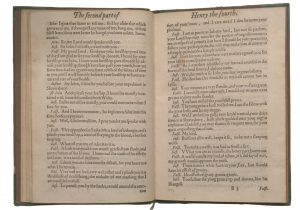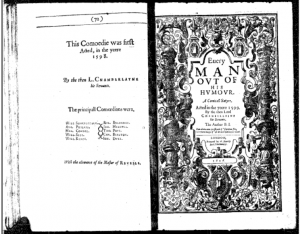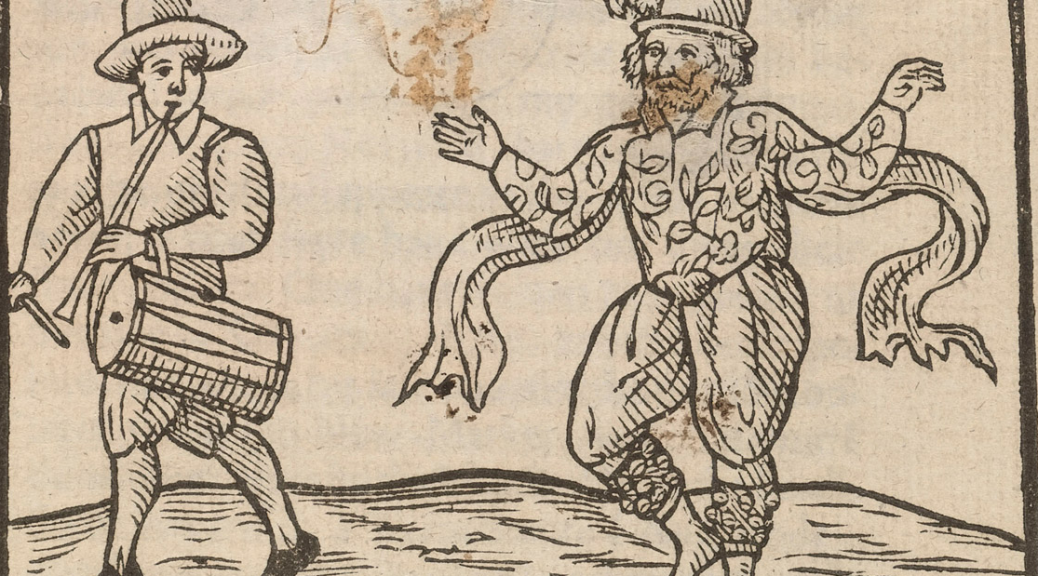That’s a long-winded title but bear with me, it gets more fun.
As a round-up on studying Elizabethan theatre history, we’re looking at 2 areas: How the nature of performances was shaped by rehearsal practicalities (Harriet) and what we learn about Shakespearean theatre from contemporaneous documents (Lucy). In this post I’ll be touching on the latter topic.
The contemporary sources I’ve looked at are mainly Thomas Platter, Philip Henslowe, and Johannes de Witt. These reveal some basic practicalities and a lot of exciting things.
Obvious things: The places of theatres. These are revealed in descriptions from de Witt’s description of his 1596 holiday to London.
“There are four amphitheatres in London of notable beauty […] The two more magnificent of these are situated to the southward beyond the Thames, and […] are called the Rose and the Swan.” [x]
It’s nice to imagine that this proximity might have generated a friendly business rivalry, especially as the Globe – Shakespeare and co’s new home – would be built a stone’s throw from the Rose. Other info Platter gives us is on showtimes and theatre management (ticket costs, seating, etc).
“Thus daily at two in the afternoon, London has sometimes three [x] plays running in different places […] For whoever cares to stand below only pays one English penny, but if he wishes to sit he enters by another door, and pays another penny…” [x]
Exciting things: This covers popular plays, lost plays, and playhouse scandals. Firstly, extracts from Henslowe’s Diary list all the shows performed over certain years, so it’s possible to tell which were most popular with Elizabethan audiences. Tamburlaine the Great and its sequel, for example, were performed 18 times in 1594/5, whereas Doctor Faustus only 10 times. I find notes like this particularly interesting because nowadays, Faustus is far more acclaimed than Tamburlaine.
Similarly, Henslowe lists a lot of plays that simply do not exist any more. Could we have lost a play that was more successful or better-written than what survives?
Skirting scandal, business rivalry. Here we move beyond theatre practicalities to legend, and while this is a long theory, and not fully substantiated by academics, it’s a wild ride nonetheless (and based entirely on contemporary documents!).
In his book Shakespeare and his Players, Martin Holmes fills in the gaps of a story concerning why ‘Falstaff’ used to be ‘Oldcastle’, why a rival company tried to defame Shakespeare, and how they concluded the fight by placing their plays in print.
Falstaff/Oldcastle: There is abundant evidence to argue that in initial performances of Henry IV, the character Sir John Falstaff was originally called Sir John Oldcastle. Why? There was a real Sir John Oldcastle from the time of Henry IV, a controversial rebel and Lord – hence he figures in Shakespeare’s play. Unfortunately, this Oldcastle had a descendant living in Shakespeare’s day who really didn’t like his family being defamed. This was Lord Cobham. As a result, Shakespeare rapidly renamed the character and added an epilogue disclaiming that Falstaff was ever Oldcastle – but traces were left behind.

“…for
any thing I know, Falstaff shall die of a sweat
unless already a’ be killed with your hard
opinions; for Oldcastle died a martyr, and this is
not the man.” (Henry IV Part II, Epilogue.)
Business rivalry: Naturally this mis-step provided a golden opportunity for another company to tell the ‘true’ story of John Oldcastle – presenting him, of course, as a pious man and no rollicking drunkard – thereby casting some shade at Shakespeare for political subversiveness. Indeed, this new play, performed by the Admiral’s Men, has a cast of characters very similar to Henry IV…
This next bit links to Harriet’s points about typecasting. Martin Holmes and many academics theorise that William Kempe played Falstaff, and so when Kempe left the Lord Chamberlain’s men, the company could no longer perform the plays with Falstaff in (the audience would not have been happy to see a different Falstaff). Particularly, they couldn’t perform Henry IV. This left the Admiral’s Men and Alleyn free to defame Shakespeare’s Henry IV by presenting the ‘true’ version of events, until both went into print – which happened within 12 days of each other – in 1600. First Sir John Oldcastle (on 11th August 1600), and then Henry IV Part II (on 23rd August 1600). This is a stretch, but you could suggest that Shakespeare deliberately released his play once he knew his rivals had, in order that the public could read for themselves that Oldcastle was not in Henry IV.
Finally, on a separate note (aka I’ve been digging too deep into EEBO). Proof that Kempe left in late 1598/early 1599! Kempe is on the cast list for Every Man in His Humour, 1598 (first perfomed some time after July) but not Every Man Out of His Humour, 1599.

On the left: final page for Every Man in His Humour, listing ‘Will Shakespeare’ and ‘Will Kempe’ among the players. Facing is the title page for Every Man Out – and here is its final page, where Kempe is not listed.
This supports Holmes’ argument, but doesn’t prove it. However it’s a fun rabbit hole to dive down.
Kempe, too, gets a vaguely happy ending. He dies in 1603 but before then, in 1600, completed his still-famous ‘Nine Days Wonder‘ of dancing from London to Norwich. The dancing is understandable as Kempe was famous for his post-show jigs, but why he wanted to go to Norwich is less clear. Maybe it was nicer then.

Lucy Thompson


An exemplary blog-post! I think your tone is spot on here: you start with a clear explanation about where we’re going with this post, but manage to keep your content interesting and accessible. The referencing by using hyperlinks is a really good idea too! I can see that you’ve also done a lot of reading around the topic, e.g. the Oldcastle scandal, which you link to the other blog-post from your group, and extrapolate (carefully!) from there.
And yeah, Norwich’s current reputation aside, at the time it was the second largest population in England, with a large amount of Dutch and Flemish immigrants who helped to make Norwich rich through their skillz in producing new textiles.